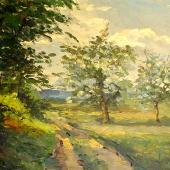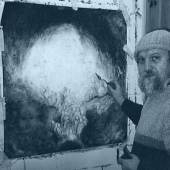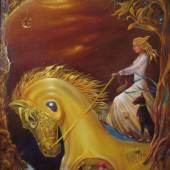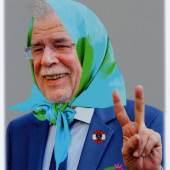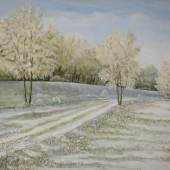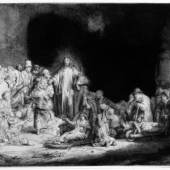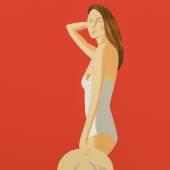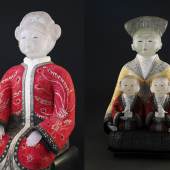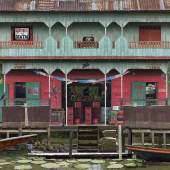International Art Fair
Art Concept, MIAMI 2016
-
Messe29.11.2016 - 04.12.2016
Understanding the wellspring of any artist’s creativity is often a difficult task. And Cuatrecasas compounded this task because he was purposely discreet; refusing to speak about his sources of inspiration or the messages he wished his paintings to impart. His role as a colorist began at Yale with Albers and continued to develop in Mexico and Washington. However, it is clear that the shapes he imbued with color reveal that their fountainhead was his exposure to and fascination with his father’s lifelong obsession with discovering and documenting what came to be 126 new species of a rare plant form that only exists at an altitude of about 15,000 feet in the northern end of Andes mountain range — the espeletia, commonly known as the frailejón. This bizarre plant produces daisy-like flowers on stalks that are protected by a central cluster of long broad leaves radiating like a crown sitting atop a thick cactus-like column nearly twelve feet tall — the whole appearing as a fantastic surreal sculpture. José’s pioneering work on this rare plant earned him accolades as one of the world’s great botanists. His magnum opus, A Systematic Study of the Subtribe Espeletinae, took a lifetime and was so massive that it was published 17 years posthumously in 2013.
It is not surprising, then, that his boys found great pleasure examining various life forms with the microscope given to them by their father. Gil was particularly fascinated by his father’s botanical drawings of the plant’s parts, especially its distinctive broad leaves. In Washington, Gil began to tap his father’s extensive herbarium of specimens of the leaves of the frailejón and began incorporating them with color paper fragments in a series of collages — an exercise learned from Albers.2 In addition, during the early 1960s he was commissioned to produce nearly one thousand exacting pen-and-ink botanical illustrations for a series of his father’s publications — and at least five-hundred of these drawings are in the collection of the Smithsonian Institution. The use of the herbarium for documenting a pharmacopoeia of Andean culture also had an impact upon Gil’s younger brother, Pedro, who became a renowned research pharmacologist.
Stylistically, therefore, many of the paintings in the Torino series reach beyond the purely non-objective, as they draw inspiration from the familiar botanical shapes of Cuatrecasas’s youth. The same broad leaves reappear consistently in his paintings but they are often not immediately recognizable. Cuatrecasas’s colleague Morris Louis also created a stylistically similar floral series but he used the very different technique of pouring thinned acrylics on raw canvas. These paintings, composed of overlapping leaf-like shapes of color, were produced in 1959–60 during a time when Cuatrecasas was also incorporating leaves into his collages and paintings.
Cuatrecasas created another prevalent botanical shape in his paintings, which he called the “thickets,” and these may have been a cross-section or “fingerprint” of the frailejón’s woody columnar stalk. Together, the broad leaves and the spikey stalk are recurring biomorphic shapes that play important roles, often overlaying each other and forming patterns while reveling in color.
Developing Avant-Garde Techniques
Cuatrecasas perfected decalcomania, an uncommon technique — discovered by the Spanish surrealist, Oscar Dominguez [1906–1957] in 1936 — where biomorphic dendritic patterns are created by chance. Invoking José’s documentation of many types of leaf forms, Cuatrecasas likely would draw a large frailejón leaf on a firm paperboard (or another firm material) and then cut it out to create a master plate. He would then paint the face of the plate, and with pigments still wet press the plate firmly onto the surface of the canvas. After rubbing the plate he would then have peeled it away. The transferred image revealed a delightfully unpredictable branching with an intriguing texture. The results vary depending upon the degree of manual pressure applied, the viscosity of the pigment, and the speed with which the plate is pulled off. The pigments typically form dendritic ridges similar to the crystalline tree-like patterns occurring naturally in certain moss agates. Cuatrecasas was certainly aware of the surrealist Max Ernst [1891–1976] who took decalcomania to new heights by creating a fusion of forms that appear to be figures and other natural forms in a kind of organic decay.
However enigmatic was Cuatrecasas’s character, it seems that he felt that his images should be even more mysteriously compelling, and he deepened the secret of his style by employing a mosaic of complex techniques. Beyond his pouring of pigments, the frottage, and the wet-on-wet folding of the canvas he also painted, crumpled, and pressed into service thin plastic sheets as tools to create texture — and even scraped away layers. Finally, subtle layers of glazing in his paintings add a diaphanous depth and bring out color.
Ultimately, Cuatrecasas’s paintings reveal their greatest affinity with the work of another colleague with whom he exhibited in Washington, D.C. — Sam Gilliam. Working 4,000 miles apart and unaware of each other’s latest experiments during the late 1960s–early 1970s, these two artists developed parallel styles independently, suggesting a spiritual zeitgeist, as they employed a brushless wet-on-wet technique with folding, creasing, and frottage. Viewers are inevitably drawn to protracted explorations of their canvases.
- << MasterArt Paris at La Biennale
- zurück | vor
- PARALLEL VIENNA 2016 >>
-
Schließlich nimmt Rembrandts mit dem Amsterdamer Kunsthändler Hendrik van Uylenburgh...
-
29.11.2016 - 04.12.2016Messe »
Concept fair tickets
One-Day ticket $20
Multiple Day Ticket $30
Group Tickets (10 or more) $122016 Opening Days
Wednesday, November 30, 1pm – 10pm
Thursday, December 1, 1pm – 10pm
Friday, December 2, 1pm – 10pm
Saturday, December 3, 1pm – 10pm
Sunday, December 4, 1pm – 7pm
